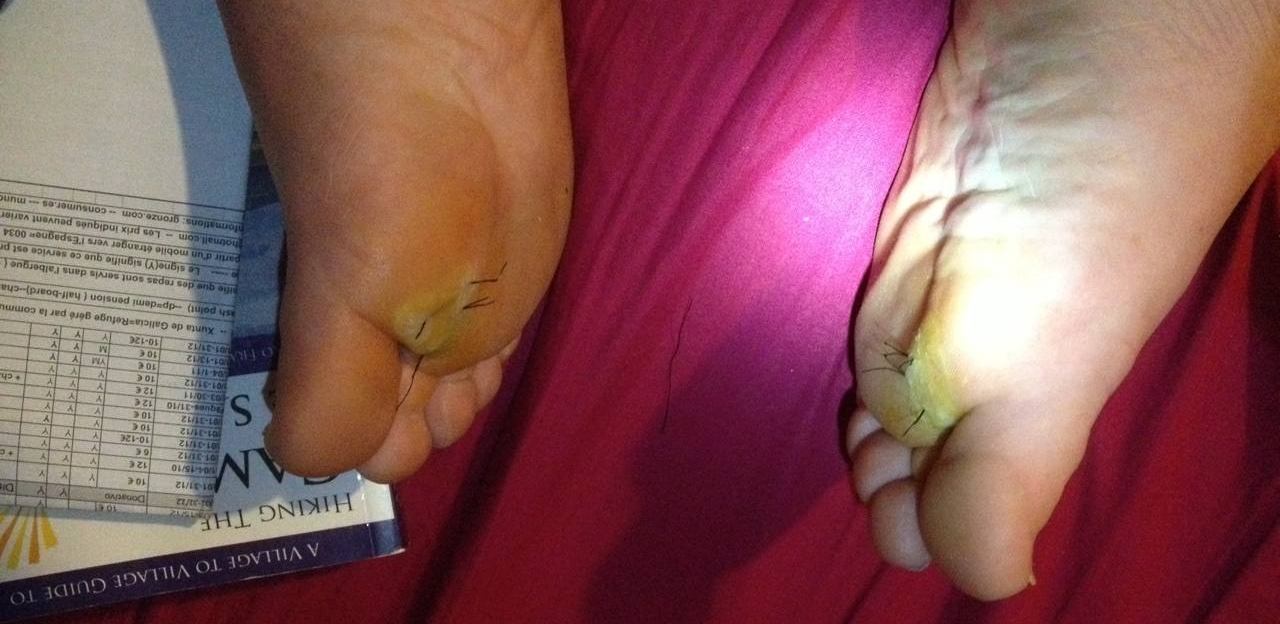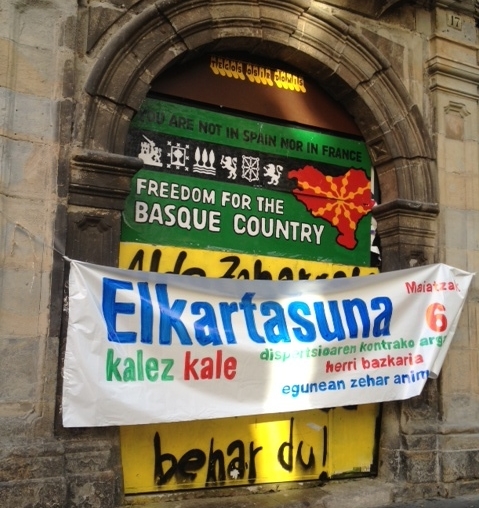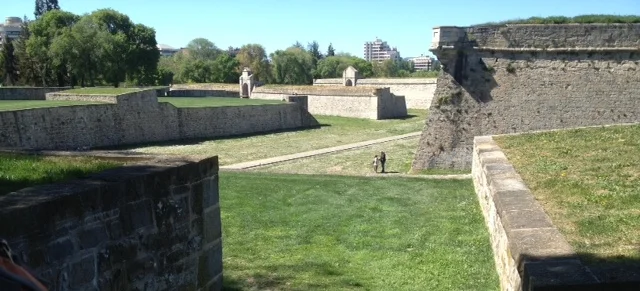Camino Day 7: Villamayor, Torres del Rio, and rain
/Impending rain, from a rooftop albergue room in Villamayor
For the first few days, the heat and sunshine was intense.
Now, in northern Spain, the weather is changing. I thought I would have been glad for clouds and cold weather, until it dropped to about 50 degrees (or maybe lower - it felt lower) with rain squalls and gusty wind. The farmers' vineyards and olive groves are surely happy for the rain - we're in wine-and-olive country now, and the soil already looks parched. Some of the farmers here already have their first cutting of hay baled in the fields, even though it's only April:
Those are black-plastic-wrapped rows of bales, a first-cutting harvest that's a full two months earlier here than at home. That stormy sky turned menacing, along a 12 km stretch of road between Villamayor and Los Arcos with no services and not so much as a single hut, though there were some lovely wetlands and rolling hills.
Speaking of wine country and wine, apparently this region of Spain is quite famous for its red wine, and one particular vineyard - the Irache Monastery - is famous for giving away wine to pilgrims for free. Yesterday passed the much-talked-about FREE WINE FOUNTAIN, which had been discussed on the trail for several kilometers in anticipation leading up to this point. (Several, several kilometers. While many of us are listening to music while walking, that doesn't change the fact that it's just... a lot of walking. At the start I thought camino-walkers were just friendly, for striking up conversations with everyone they passed. Now I think it's sheer boredom. I've begun to feel the same desperation, when kilometers pass without a soul in sight and then you hear the clatter of walking sticks and think delightedly, "Ah! Someone's passing me! How exciting!" And if it's another solo walker, you meet each other's eyes and say with a sort of frantic need for distraction, "BUEN CAMINO! Where are you from?!" Today I met a very friendly Italian man who spoke barely any English but did speak German, because he's working in Stuttgart, and he recommended another long-distance walk - the 300 km 'Strasse Romantico' that leads to Neuschwanstein Palace.) Anyway, shortly after the 100 kilmeter mark - a marker which at first I found heartening, until I then realized it meant there was 700 km to go - came the Irache Wine Fountain. It's a very elegant setup on the monastery's wall outside, with two metal spigots. One dispenses water; the other, wine.
A sign begs for restraint, saying the fountain is stocked with only 100 liters a day so please indulge modestly, that other pilgrims may enjoy their taste. But no one monitors how much you take. I put a few generous swallows in my water bottle, to save for later:
(I later enjoyed it in a freezing-cold attic room with two Lithuanians and a Frenchman and another guy, after the Lithuanians gave me antiseptic and taught me how to string thread through a blister) (It was... not bad wine).
Toward the end of that day's walk, I came upon the most magical spot yet. It was after a rain squall, and the trail was deserted. I'd heard about the 'Fuente de los Moros' ruins, an old water source rumored to be from the Moors but possibly much older, but I wasn't paying much attention. I was mostly just sodden and cold and my feet hurt from the blisters and I was worried I wouldn't get a bed in the upcoming town of Villamayor, because there were only 2 small albergues and NOBODY would want to continue through that desolate 12 km stretch in weather like this, so everybody would be stopping. Then I turned the corner, and directly beside the trail - which must be an ancient trail indeed, if a Moor water source was built alongside it - was this:
Quite solid-looking despite its weathered stones, which are growing moss on closer inspection. And from inside in the shadows - behind those arches - came a gentle, mysterious trickling. The inside had steps leading down - old, worn stone steps - and they descended straight into a pool of water, with an old sort of cistern submerged in the center, and goldfish living in the pool. Goldfish. Just living in this ancient moorish water source, all year round, while it seeps softly from a hole in the back wall, day and night.
Such a simple building - three solid walls, with steps from left to right, flush with the walls on both sides, and that cistern centered in the water, and arches looking out across the hillside above.
So symmetrical and focused. One of the most beautiful spaces I've ever been in, even after all our fancy modern architecture lessons and field trips to modern spaces. Stone. Trickling water. Goldfish. Worn steps. Descent underground. And this feeling of eternity, the echo amplifying that trickling that never stops.
Anyway, after seeing this I got one of the last beds available in Villamayor, just before a rain squall. I climbed to the attic loft. I unrolled my sleeping bag on a bed, beside two Lithuanians. Then I limped to the grocery store, and then limped to the small village church, and I sat in the empty dark alone with gray light trickling through slit windows... and wept. It had been years since I cried. This was a helpless sort of crying, and when the church-tender came in to trim the candles I think I scared him. But I couldn't stop. Helplessness, how I hate it. I hate being in pain, and I hate not being in control, and I hate relying on others, and I hate being poor. I think I got the very last bed in Villamayor; all the walkers arriving after me had to continue on, or buy a taxi. I could not have continued on, not 12 km to the next town. And I don't have money for a taxi, not if I want to last 7 weeks here with what little I have saved. So I cried alone in a dark church, and bowed my head and felt embarrassed for crying, and sent up a prayer of gratitude and apology to a god that might be listening.
I'm sorry for thinking this would be easy.
Walking. Just walking. I'd arrived thinking a pilgrimage would be nothing. A cheap way to see the country, not a trial at all. Blisters aren't even a serious injury, and already the fear of being unable to continue - the vividness of having only your own body for transport, and the terror of being left stranded should your own body fail - had me humbled and ashamed. I'd seen so many others limping, in so much more pain than me.
Anyway. I thanked the hostel owner for the lovely pink-sheeted bed in the attic, and then thanked the Lithuanian lady who helped me disinfect and thread string through my blisters with a needle:
Mostly, I just thanked a lot of people. And the next day, walked about 20 km onward (on threaded blisters- it helped) to Torres del Rio. Beautiful little hill town! With plenty of picturesque old stone benches tucked into alleys, perfect for enjoying a 5-euro supper of canned garbanzo beans, canned sardines, bread and cheese.
The albergue in Torres del Rio was over a bar, and when I went down to the bar to borrow a pair of scissors (to cut a new pair of insoles down to size, because I got a pharmacist's recommendation on disinfectant, moisture-wicking insoles, and blister bandages) I got the most excellent advice. A random man was sitting there at the bar eating quiche, when I asked the bartender for tijeras, and held up my new insoles which needed cutting. I mentioned something about my feet hurting, and blisters, and this middle-aged guy stopped eating his quiche and took one at my insoles and said very wisely, "Mira, mira". Then- with great fanfare - he reached into his coat pocket.
He said (in spanish) that I had to keep my feet dry, and he knew just the trick, he'd been doing this for years. He flipped my insole over, unfolded something across the bottom, and asked if I knew what it was.
A women's maxi pad. Already unfolded in its wrapping, ready to be stuck to the bottom of HIS insole the following morning. I said "si, si, por supuesto, una cosa para mujeres", and, with a secretive look around the bar to make sure no one else had seen him pulling maxi pads from his coat, he tucked it away again as several more customers came in through the door. "Exacto," he said. He told me to buy some of these, the thickest kind I could find, and if I could, buy the kind with wings, to wrap around the insole from below, to keep it in place. (I will now never forget that the word 'alas' means wings in spanish, because I heard it from this man at the bar making flapping gestures with his arms as he tried to explain to me what kind of maxi pads I should buy.) Stick the maxi pad under the insole, pad facing down, sticky side stuck to the insole, and it adds some padding to keep the ball of your foot from slipping while also absorbing moisture. Change the maxi pad every 1-2 days, and voila.
Excellent advice from a long-walk-loving Spaniard in a bar. The following morning at sunrise, I bought maxi pads from a small shop beside the trail, which sells them individually for just such occasions as this.
Buen Camino,
-mlj



























